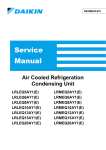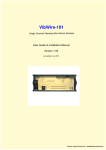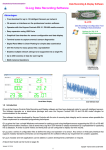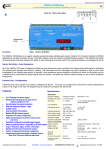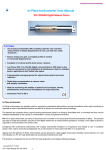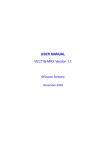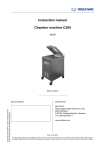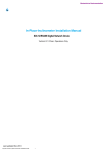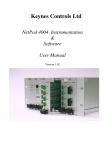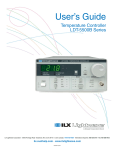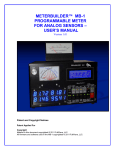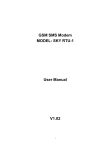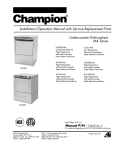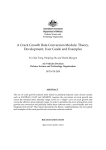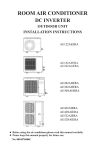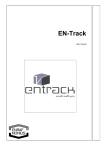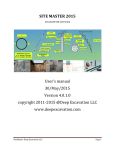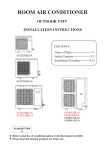Download VibWire-108 Manual - Keynes Controls Ltd
Transcript
VibWire-108 8 Channel Vibrating Wire Sensor Interface User Guide & Installation Manual Version 1.09 Last updated 17/04/2014 contact: Keynes Controls Ltd - [email protected] VibWire-108 User Manual V1.09 1 WARRANTY Keynes Controls Ltd warrants its products to be free of defects in materials and workmanship, under normal use and service for a period of 12 months from the date of purchase. If the unit should malfunction, it must be returned to Keynes Controls for evaluation, freight prepaid. Upon examination by Keynes Controls Ltd, if the unit is found to be defective, it will be repaired or replaced at no charge. However the WARRANTY is VOID if the unit shows evidence of having been tampered with or shows evidence of being damaged as a result of excessive corrosion or current, heat, moisture or vibration., improper specification misuse outside of the companies control. Components which wear or become damaged by misuse are not warranted. This includes batteries, fuses and connectors. VibWire-108 User Manual V1.09 2 Introduction The following document is the User Manual and installation guide for the VibWire-108 range of instruments. The User is expected to have some prior knowledge of the SDI-12, RS-485 or Modbus network and protocols since this manual is not meant as a teaching aid for network applications. The VibWire-108 family of vibrating wire sensor interfaces have been designed to interface vibrating wire sensors from any manufacture to a data logger, PC data acquisition system, or SCADA applications. The principle operating feature of the VibWire-108 is its ability to accurately measure and report the vibrating wire sensor frequency. The instrument uses an auto-resonance technique to energise the sensor coil and adjusts the ping rate automatically to follow the sensor operation. The auto-resonance feature enables the sensors to be automatically configured as the instrument adjusts the coil excitation to maximise the signal to noise ratio without excessive strain put to the sensor coil. 1435.2 Hardware Options VibWire-108-RS485 VibWire-108-SDI12 VibWire-108-Modbus VibWire-108-Analog with RS-485 network option with SDI-12 network option with RS-485 Modbus option with analogue output option Dynamic & Static Measurement Applications The VibWire-108 is ideally suited to static measurement applications. In applications requiring samples rates of 1 - 10 Samples/ Sec then a new keynes Controls product the VibWire-101-RS232 will be required. See http://www.aquabat.net/HighSpeedVW/high-speed-vw101v1.html Configuration For SDI-12, RS485 and Modbus network operations the sensor input ranges are automatically assigned. The only time the VW-108 requires any sensor frequency configuration is when the analogue output representation of the input signal is being used. SI Units The VibWire-108 can be set-up to supply results directly in units of Hz, Digits (Hz2) , and Engineering units. The vibrating wire sensor engineering unit conversion is carried out using the industry standard quadratic equation expansion. The vibrating wire sensor thermistor values are converted to temperature using the Steinhart-Hart equation to give values in Deg C or can be supplied in raw mV format. VibWire-108 User Manual V1.09 3 Features 8 x 4 Wire Vibrating Wire Sensor Inputs Resolves the VW signal to less than 0.001 Hz (industry standard 0.1 Hz) Gas Discharge Tube Sensor Protection Real-time Frequency Display - 5 digit Audible Output Auto Resonance VW Excitation SDI-12 Network Support Firmware Upgrade facility Automatic VW sensor configuration Digital communications to remove noise sources and errors. Simplified configuration and data logger support. Output - Frequency, Digits, SI Units, Temp Deg C Steinhart-Hart Thermistor Linearisation Support Integrated Polynomial Linearisation - Quadratic Support direct from VW sensor calibration data sheet. Photo VibWire-108 Field Operations All of the VibWire-108 family of interfaces contain a real-time 5 digit, 7 segment LED display that can be used to show real-time sensor frequencies for the vibrating wire sensors, and to configure the most commonly used features of the instrument. This feature is useful when configuring and testing sensors in the field. The VibWire-108 automatically resets to the network operation after a time-out period of 10 minutes and so prevents a User leaving in the wrong mode of operation. This feature ensures the instrument is always ready for operation and is useful for widely distributed applications and systems deployed in hard to reach locations. Terminal Port The VibWire-108 supports a terminal port configuration and upgrade facility. The terminal port can be used by any industry standard terminal emulator software such as the Microsoft Hyper-terminal or Token-2. The terminal port enables the vibrating wire sensor calibration factors to be stored easily into the instrument. Fully Integrated Data Recording Solutions The VibWire-108 can be connected to any suitable third party data logger or communication system supporting SDI-12, RS-485 or Modbus operations. Simple industry standard commands are used to make a reading and acquire data. The Modbus network protocol is supported for easy integration into SCADA applications. Q-LOG The VibWire-108 is fully integrated into the free Keynes Controls Q-LOG data recording and display software. The Q-LOG application software enables the VibWire-108 to be used to create PC based data recording and display solutions with little or no programming experience. The Q-Log software can be downloaded for free http://www.aquabat.net/QLOGFree/qlogv2.html Copyright Keynes Controls 2010- 2011 Release Version 1.08 1.0 Care & Maintenance The VibWire-108 family of products have been designed for long term operation and so will operate reliably for many years as long as the instrument is not mis-used and operated as shown in the manual.. Step 1 Remove any signal cables and terminal blocks from the instrument. Step 2 Clean the 4 and 5 way plug and sockets using ionised water to remove the buildup of any dirt or foreign bodies that build up on the termination pins. It is essential to remove any grease that can cause corrosion to the pins. Step 3 Allow the sockets to dry out before connecting any signal cables. Description Operating temperature –10 to 60 °C Storage temperature –10 to 85 °C Operating humidity 10 to 90% RH, non-condensing Storage humidity 5 to 95% RH, non-condensing 2.0 Default Factory Settings All instruments are set for No of Channels = 8 Default ID = 0 Models VibWire-108-SDI12, VibWire-108-RS485, VibWire-108-Modbus 3.0 Temp = 8 Required Software The VibWire-108 requires a terminal software package supporting VT100 emulation only. Recommended software Microsoft Hyper-terminal Token2 3.1 Q-Log Software The Q-Log data acquisition and display software operates with all of the USB-SDI12 and USB-RS5485 media converters Q-Log enables the VibWire-108 to operate with a PC or laptop and give the User access to the data in a familiar Windows environment When used with a USB-SDI12-Pro or USB-RS485-Pro media converters, the VibWire-108 can directly powered from the PC/Laptop USB port. Download at http://www.aquabat.net/QLOGFree/qlogv2.html Warranty Information The information in this document is subject to change without notice. Keynes Controls Ltd . has made a reasonable effort to be sure that the information contained herein is current and accurate as of the date of publication. Keynes Controls Ltd. makes no warranty of any kind with regard to this material, including, but not limited to, its fitness for a particular application. Keynes Controls Ltd will not be liable for errors contained herein or for incidental or consequential damages in connection with the furnishing, performance, or use of this material. In no event shall Keynes Controls Ltd . be liable for any claim for direct, incidental, or consequential damages arising out of, or in connection with, the sale, manufacture, delivery, or use of any product. VibWire-108 User Manual V1.09 5 4.0 Front Panel 0V +12V DC VW Sensor Inputs 1435.2 Fig 1 Analogue Output Channels Not Used in SDI-12/RS-485 & Modbus version instruments Menu Out Button Down Button 4.1 Menu In Button 7 Segment Display Up Button Circuit Board Features Gas Discharge Protection Transorb Speaker ON/OFF Switch Fig 2 Terminal Port 9 Pin DTE Ceramic Speaker Real-time 5 Digit 7 segment display 7 Segment Display VibWire-108 User Manual V1.09 6 5.0 SDI-12 Serial Network Connection The following page describes connecting the VibWire-108 to an SDI-12 network. SDI-12 data Earth Earth 0V /Gnd - SDI-12 12V DC - SDI-12 Earth Earth NPN-4 NPN-3 NPN-4 NPN-3 485 + / SDI-12 485 + 12V Gnd Fig 3 Earth Connection The menu system shown below is used by the AquaLOG data logger. Main Menu Ensure that a good Earth connection is made and fitted to each instrument in order that the lightning protection discharge tubes will operate. 1 Device Setup 2 Zigbee Mode Settings 3 GPRS Mode Settings 4 USB Memory Stick Settings 5 SDI12 Setup 6 Formulas 7 Alarms 8 Logging Operations 9 Diagnostics A System Maintenance U Up. T Top. Lightning protection is provided for all VW sensor inputs and between the SDI-12 - 0V connection. - SDI-12 Gnd/0V + SDI-12 Acquire data across the SDI-12 network for 2 x VW108 instruments and store data into the logger starting at the free cell [D] in the data table. [D] 3M! 3D0! 7M! 7D0! 5.2 Multi-Instrument Solutions SDI-12 Network Connection Use the same network connection for any 3rd party logger 5.1 For multiple instruments to operate together on an SDI-12 network then they must each have a unique ID number assigned. SDI-12 Network Operation As soon as a measurement instruction is sent by the data logger the the SDI-12 bus is activated and all the instruments are powered on. Upon receipt of the correct start measurement command then then a scan of the sensors is made and data is sent in turn to the data recorder. After all data is received the the instruments are all powered off. The SDI-12 multi-drop network requires only 3 wires to be connected between instruments for the communication of data. This ensures that the installation and use of the SDI-12 network is a very simple operation. The VibWire-108 is powered by the SDI-12 network +12V and 0V supply operations. The SDI-12 network only goes active during a measurement operation and The image below shows how a simple multi-instrument system is switched off at any other time. The SDI-12 network is is connected together to a data logger. controlled by the data recorder. 5.3 PC Data Acquisition System 5.4 Multi-instrument Data Logger Solution Figure 5 below shows how a typical multi-instrument data logger system is wired together. Additional Information The USB-SDI12 media converter only controls the network lines. Individual instruments use their own local power supply and are active continuously. - 485 Example of multi-instrument SDI-12 Application + 485 Expansion Port SDI-12 Gnd SDI-12 +12V DC SDI-12 Data Range 0 .. 100 m 1435.2 Fig 5 SDI-12 Network SDI-12 Network Fig 4 1435.2 1435.2 2135.8 1435.2 1435.2 2135.8 VibWire-108 User Manual V1.09 7 6.0 RS-485 Serial Network Connections Earth, -RS485, +RS485 lines are connected in common to all units RS485 + Common to all instruments RS485 - RS485 - Common to all instruments RS485 + 12V DC 0V Earth Earth Earth Earth NPN-4 NPN-3 NPN-4 NPN-3 4 485 + / SDI-12 485 + 12V Gnd 1 Control Signal Lines 1 2 3 4 Gnd Power - RS485 + RS485 / SDI12 Fig 6 - RS-485 12V DC 6.1 Gnd/0V + RS-485 Earth Connection Ensure that a good Earth connection is made and fitted to each instrument in order that the lightning protection discharge tubes will operate. Lightning protection is provided for all VW sensor inputs and between the RS-485 - 0V pins. Important Note Failure to fit the Earth connection will prevent the lightning protection from operating. RS-485 Network Connection 6.2 PC Data Acquisition System - RS-485 Solution Additional Information A PC based RS-485 system can operate with up to 32 instruments and to a direct network span of up to 1000 m. This is an ideal solution for large distributed applications. The USB-RS-485 media converter only controls the network lines. Individual instruments use their own local power supply and are active continually. - 485 Fig 7 + 485 Expansion Port 2135.8 Range 0 .. 100 m 1435.2 SDI-12 Network SDI-12 Network 1435.2 6.3 Large Scale Systems Deployment For applications requiring a large number of distributed instruments then simply adding a new USB-RS485 media converter to a PC will enable multiple network systems to operate together. The Keynes Controls Q-LOG software enables unlimited expansion by adding new networks to a PC at any time. In fact the software is flexible enough to enable SDI-12 and 485 networks to coexist enabling many different intelligent sensors to be used. 2135.8 VibWire-108 User Manual V1.09 8 7.0 Modbus RS-485 Network Connections The VibWire-108-modbus connects to the RS-485 network as shown below. Fig 8 SDI-12 / RS-485 digital communications Typical Q-Log Panel Meter Display - RS-485 12V DC Gnd/0V + RS-485 Laptop / PC Computer RS-485 Network Connection 8.0 PC/Laptop Data Recording & Display System Isolated USB Media Converter SDI-12 / RS485 digital network Fig 9 1435.2 1435.2 VibWire–108 VibWire–108 Isolated USB Media Converter Model No. USB-SDI12-Pro USB-RS485-Pro The image above shows how the VibWire-108 can be integrated into a PC based data recording and display solution using the Q-LOG application software. The USB-SDi12-Pro and USB-RS485-Pro media converters are used to add new network strings to the computer as and when required.. The USB-Pro range of media converters power the VibWire-108 interfaces directly from the PC USB port. All of the USB-Pro model media converters can power directly the VibWire-108 interfaces and 3rd party sensors. An external power supply can be used when large number of units are being used. 2135.8 0 5 Km depending upon signal cable quality Q-LOG will also operate with many third party intelligent sensors . VibWire-108 User Manual V1.09 9 9.0 Technical Specifications The technical specification for the different models is shown below. All of the VibWire-108 family of products use the same terminal port setting for configuration operations. Measurement Data: Number of channels 8 x 4 Wire VW Inputs - User Selectable VW sensor coil resistance to 2 K Ohm (standard):- other ranges on request Distance of VW sensor to interface 0 .. 10 Km depending on cabling. Frequency range 400 - 6 KHz (standard) Other ranges on request Frequency Resolution Accuracy 32 bit resolution 0.001 Hz Long term stability ± 0.05 % FS max / year Temperature range - 50 to 70 Deg C Temperature resolution 0.1 oC +/- 0.2 Deg Thermistor 10 K Ohm standard 3.3 K Ohm on request Temperature accuracy ± 0.2 Thermistor measurement A half bridge ratio-metric measurement. Value returned in mV. Is used for temperature compensation on VW measurements using Steinhart-Hart thermistor equation or beta value. Thermistor excitation 2.5 V DC 50 ppm /Deg C Input resistance 10 K Ohm 0.1 % Completion resistor (Standard) 3.3 K Ohm on request Units Freq (Hz), Digits (Hz2), SI Units, Temperature Deg C, mV Display only - Resolution 5 digit - 0.1 Hz oC / 0.2 oF SDI-12 Electrical Data Voltage supply SDI-12 10.5 to 16V DC Current compensation SDI-12 Option only Typical values are @ 12 V DC Excitation Idle mode Active / measurement 1.2 mA 8 mA data transmission 58 mA including frequency display These values may change slightly between sensors. Use figures as a guide only. Measuring time warm up response 500 ms 3 seconds per channel depending on the VW sensor being used (Typical) Length of data lines SDI-12 0 .. 100 m SDI-12 Address mode Supports enhanced addressing 0 .. 9 A .. Z General Data: Dimensions (mm) L =260 Material Powder coated aluminium W = 127 D = 38 SDI-12 Digital Port SDI-12, 1200 Baud, 7 bit, N stop bit, Even Parity - other speeds on request CE Conformity CE conformity according to EN 61000-6 Weight 400 g Communications Terminal Port 9 Way Male - 9600 Baud 8 data, No Parity, 1 stop bit, No Flow control - DTE SDI-12 Digital Port 1200 Baud, 7 bit, N stop bit, Even Parity - other speeds on request RS-485 Network Settings 1200 Baud, 7 data bit, N stop bit, even parity RS-485 Network Settings - modbus 9600 Baud, 8 data bit, 1 stop bit, even parity 10.0 System Test - Power on sequence The instructions are the same for all models. Step 1 - Power on the VibWire-108. Response Apply 12V DC to the power connector shown on Fig 1, Page 6 The VibWire-108 will briefly show the message ‘HELLO’ on the 5 Digit LED Display. Step 2 - The display will default to ‘0’ on the LED display. The instrument will wait until a start measurement command is received before a measurement is made. VibWire-108 User Manual V1.09 10 11.0 VibWire-108 Digital Communications The instructions below detail the operations to follow to operate the VibWire-108 across both the SDI-12 and RS-485 serial networks. No sensor configuration details need be applied to the VibWire-108 when operating with the cable free transmitter, RS-485 or SDI-12 network. Simply connect the sensors to the interface as shown in Fig 2 and initiate the commands listed below. Recommended Test Use a single instrument only when undertaking initial measurements with a VibWire-108 on the RS-485 or SDI-12 network. This simplifies the software and will speed up the understanding of the command used to obtain data. It is very easy to test the results measured across the RS-485 and SDI-12 network with the ones shown on-board frequency display of the unit. The results obtained across the RS-485 and SDI-12 network will be same as those shown on the display for a specified channel. The default instrument address for a unit straight out of the box is 0 - results will be random numbers with no sensors installed. Test Measurement Issue command 0M! to start measurement operations. The VibWire-108 will scan all channels 0D0! returns items of data 0 Freq Chan 0 + Freq Chan 1 + Freq Chan 2 + Freq Chan 3 Ensure that each instrument used on a network has a unique ID number assigned within its configuration in order to correctly identify the data that is being recorded. 11.1 Command Structure & Operations across an RS-485 network The VibWire-108 uses a command structure across the RS-485 network very similar to that used by the SDI-12 network in order to simplify the overall system operations. Understanding the control of the instrument on one network be that RS-485 or SDI-12 will make using the the unit on the other a very simple operation. The RS-485 and SDI-12 network both operate at the same speed of 1200 baud. The RS-485 network speed can be increased at the time of manufacture. Currently it is factory set. Even though this is a relatively slow rate, as networks go, it is more than adequate for the small amounts of data transmitted by the instrument. No break characters are transmitted in an RS-485 command and any sent will be ignored by the instrument. A short delay of approximately 10 ms is added between a command received by VibWire-108 and its transmission of data since this delay is used to allow time for the host PC to turn off its transmitter when using soft-negotiation for data flow control operations. Under normal RS-485 data transmission operations the RTS line on the serial port is used for flow control operations. Keynes Controls recommends an RS-485 interface with hardware negotiation is used to control the VibWire-108 across a network. 11.2 Timing Constraints RS-485 / SDI-12 Network There are no timing constraints for the transmission of instructions and receipt of data across an RS-485 network compared to the operations on and SDI-12 network. Data Access Time 12 mS 8 mS SDI-12 Data Figure 10 shows timing delay used on SDI-12 serial bus prior to sending data Typically the VibWire-108 takes 5 seconds to complete the scan of the first sensor and a further 3 seconds for any other sensor connected to the instrument. The actual response time for the instrument is dependent upon number of sensor fitted and can interrogated using the aM! command. 11.3 RS-485/ SDI-12 Commands The commands used by instruments on the SDI-12 and RS485 network are the same In the following commands 'a' and 'b' are the address of the instrument and can only be integers 0 to 9 or the characters a - z. where 'ttt' represents a time in seconds (0 to 999 seconds) 'n' or 'nn' represents a number of channels (00 to 99 channels) \r and \n are the Carriage Return and Line Feed characters - ASCII 13 and 10. VibWire-108 User Manual V1.09 11 11.4 Assigning Data Transmission over the SDI-12 or RS-485 Network All of the VibWire-108 models use the SERAL option to assign the data transmission operations across the digital network. A 10 minute time-out feature ensures that the instruments cannot be left displaying real-time frequency results. For Modbus operations the instrument scans automatically at the pre-set sample time as soon as power is applied, see page 24 for setting the sample time. The Modbus ID is set exactly the same as for the SDI-12 and normal RS-485 operations. 11.5 Starting Data Acquisition Operation on a SDI-12 Network To activate the analogue output channels on the VibWire-108. Instrument Identifier Each instrument deployed on the SDI-12 multi-drop network must have a unique instrument identifier set in order to identify specific instrument on the network. For the SDI-12 network this identifier is 0-9. The SDI-12 ID can be expanded upon request. 1. Starting at 2. Select “Menu In” button 3. Use the Up & Down Keys to select the option “SERAL” See Page 8 for details on setting the ID number. “Analg C0d C1d C2d C3d C4d C5d C6d C7d” are the other options available Once the “Seral” output is selected the “Menu Out” key has to be pressed to confirm this option. 4. The VW-108 will return to the display SDI-12 and RS485 operations are only possible when the VibWire108 is in serial port mode. This is indicated by activating the ‘SErAL’ option. and now the SDI-12/RS-485 port for the instrument is now activated. 11.6 Starting Data Acquisition Operation on a 485 Network Instrument Identifier To activate the SDI-12/ 485 output channels on the VibWire-108 Each instrument deployed on the RS-485 multi-drop network must have a unique instrument identifier (ID) set in order to 1. Starting at identify specific instrument on the network. For the RS-485 network this identifier is 0-31. The SDI-12 ID can be expanded upon request. 2. Select “Menu In” button 3. Use the Up & Down Keys to select the option “SErAL” See Page 26 for details on setting the ID number using the keyboard menu system. System Maintenance option of the terminal menu system page 23. “Analg C0d C1d C2d C3d C4d C5d C6d C7d” are the other options available Once the “SErAL” output is selected the “Menu Out” key has to be pressed to confirm this option. 4. The VW-108 will return to the display and now the SDI-12/RS-485 port of the instrument are now activated. 11.7 Modbus version instrument The Modbus version instrument will start the scan sequence automatically as soon as power is applied. The scan period is set using the built in menu system using the keyboard. See page 24, section 23.3 for details. VibWire-108 User Manual V1.09 12 12.0 Instrument Identifier Each instrument deployed on the multi-drop network must have a unique instrument identifier set in order to identify specific instrument on the network: For the RS-485 network this identifier is in the range 0-9 / a-z. For the SDI-12 network then the ID number is in the range 0..9 - Additional ID numbers are supported a .. z. For Modbus operations the ID number is currently limited to 1 .. 32. 13.0 Start Measurement Commands There are 2 separate commands supported by the VibWire-108 for initiating measurements across an RS-485 network and are named ‘aM!’ and ‘aC!’. Table 1 includes a complete description of the commands used by the VibWire-108 The ‘aM!’ starts a measurement and responds as soon as the data is ready to be transmitted from the instrument. This command returns all instrument sensor inputs as a string The ‘aC!’ command starts concurrent operations that are used to initiate measurements upon multiple instruments deployed across the network. The ‘aC!’ command frees the network bus so that other devices can operate freely. 14.0 Advice on the choice of measurement commands The VibWire-108 supports both the individual and concurrent start measurement commands. Keynes recommends using individual start measurement commands where there are large distances between devices and the network cable installation quality is poor. Should there be substantial voltage losses on the supply cable then the additional load of a lot of sensors scanning simultaneously may cause errors with some instruments being unable to operate correctly. For fast results and small scale systems then the concurrent start measurement command can be used. 14.1 Possible Network Problems Should a larger than expect load be put onto the SDI-12 network then the voltage drop between 0 V and SDI-12 12 V supply can be as high as 2 V. If this is the case then the instrument may not respond as expected. Copyright Keynes Controls 2008- 2009 Release Version 1.06 VibWire-108 User Manual V1.09 13 15.0 SDI-12 Supported Commands The following commands are supported by the VibWire-108 SDI-12 model Description Master VibWire-108 Response Acknowledge active a! a\r\n Send ID: aI! a13KEYNESCOVibWire-1080001\r\n provided to complement SDI-12 protocol Part Description assigned by Keynes Address Query ?! a\r\n identifies instrument address and commonly used on single instrument operations only. Used to make command set SDI-12 compatible Where a = ID number 0 - 9 (standard) / (a..z) Enhanced SDI-12 0 - 9 / a - z for RS485 Change Address: aAb! b\r\n used to change instrument address from a (inital) to b new ID for network operations a = initial address Start Measurement aM! a0268\r\n instruct an instrument to make measurement a = address of instrument example 0M! starts scan for ID 0 instrument with address a returns 8 x vibwire & 8 x temp after 60 seconds Concurrent measurement: aC! a0268\r\n Used for starting a measurement for all instruments on a network at the same time. start measurement instrument address a initial response only after receipt of instruct and no response when data ready to be sent. Send data aD0! aD1! aD2! or aD3! +xxxx.x+xxxx.x+xxxx.x+xxxx.x\r\n data returned aND! = Vib + Vib + Therm + Therm and has same format for each command aD0! = channel 0 and 3 aD1! = channel 4 and 7 aD2! = channel 0 and 3 aD3! = channel 4 and 7 Thermistor 1 & 2 VibWire-108 supports 2 thermistor types b = new address a:b = number 0 - 9 or a - z This command frees RS-485 bus for other devices Thermistor Type 1 Temperature sensor settings VibWire Sens VibWire Sens Therm/analog Therm/analog aXT1RE! aXT1T0! = 25 aXT1BET! Resistance at 25 Deg C T0 - generally 25 Deg C Beta Value aXT1ST0! aXT1ST1! aXT1ST2! aXT1ST3! A in Steinhart-Hart B in Steinhart-Hart C in Steinhart-Hart D in Steinhart-Hart aXT2RE! aXT2T0! = 25 aXT2BET! Resistance at 25 Deg C T0 - generally 25 Deg C Beta Value Page 36 shows sample calibration data sheet aXT2ST0! aXT2ST1! aXT2ST2! aXT2ST3! A in Steinhart-Hart B in Steinhart-Hart C in Steinhart-Hart D in Steinhart-Hart VW Sensor Input Channel Settings aXCH0FN! 0 = output in Hz 1 = output in digits = F^2/1000 2 = use formula A + B*digits + C*digits^2 + D*temperature Parameters from the sensor calibration sheet Steinhart-Hart Parameters Thermistor resistance/temp calculation Thermistor Type 2 Temperature sensor settings Parameters from the sensor calibration sheet Steinhart-Hart Parameters Thermistor resistance/temp calculation F = Frequency type N = VW Channel 0 .. 7 digits = Frequency2 in units of Hz2 Therrmistor Type aXCH0TN! = Thermistor type The VW108 supports 2 different thermistor types for temperature measurement. where a = ID T = Thermistor Type N = Thermistor Channel Input = 0..7 Thermistor Temperature Calculation aXT1TYn! 0 = resistance ratio - thermistor data sheet (Rt/R25) a = ID 1 = Beta value calculation 1/T = 1/T0 + log(r)/Beta n = integer 0 .. 2 0 = Voltage ratio 1 = Type 1 thermistor (use XT1RE etc. as above) 2 = Type 2 thermistor 11 = Type 1 resistance ratio, output Rt/R25 12 = Type 2 resistance ratio, output Rt/R25 99 = Output mV at terminal where r = Rt/R25 2 = Steinhart-hart equation 1/T = A + B(Ln Rt/R25) + C(Ln Rt/R25)2 + D(Ln Rt/R25)3 VibWire-108 User Manual V1.09 14 16.0 RS-485 Supported Commands The instrument commands for the RS-485 and SDI-12 versions of the instrument are identical except for the “%” prefix at the start of the command. See table below Description Master VibWire-108 Response Acknowledge active %a! a\r\n Send ID: %aI! a13KEYNESCOVibWire-1080001\r\n provided to complement SDI-12 protocol Part Description assigned by Keynes Address query %?! a\r\n identifies instrument address and commonly used on single instrument operations only. Used to make command set SDI-12 compatible Where a = number 0 - 9 for SDI-12 0 -9 letters a - z for RS485 A-Z Change Address: %aAb! b\r\n used to change instrument address from a (inital) to b new ID for network operations a = initial address Start Measurement %aM! a0268\r\n instruct an instrument to make measurement a = address of instrument example 0M! starts scan for ID 0 instrument with address a returns 8 x vibwire & 8 x temp after 60 seconds Concurrent measurement: %aC! a0268\r\n Used for starting a measurement for all instruments on a network at the same time. start measurement instrument address a initial response only after receipt of instruct and no response when data ready to be sent. Send data %aD0! aD1! aD2! or aD3! +xxxx.x+xxxx.x+xxxx.x+xxxx.x\r\n data returned aND! = Vib + Vib + Therm + Therm and has same format for each command aD0! = channel 0 and 3 aD1! = channel 4 and 7 aD2! = channel 0 and 3 aD3! = channel 4 and 7 Thermistor 1 & 2 VibWire-108 supports 2 thermistor types b = new address a:b = number 0 - 9 or a - z This command frees RS-485 bus for other devices Thermistor Type 1 Temperature sensor settings VibWire Sens VibWire Sens Therm/analog Therm/analog %aXT1RE! %aXT1T0! = 25 %aXT1BET! Resistance at 25 Deg C T0 - generally 25 Deg C Beta Value %aXT1ST0! %aXT1ST1! %aXT1ST2! %aXT1ST3! A in Steinhart-Hart B in Steinhart-Hart C in Steinhart-Hart D in Steinhart-Hart %aXT2RE! %aXT2T0! = 25 %aXT2BET! Resistance at 25 Deg C T0 - generally 25 Deg C Beta Value See page 36 %aXT2ST0! %aXT2ST1! %aXT2ST2! %aXT2ST3! A in Steinhart-Hart B in Steinhart-Hart C in Steinhart-Hart D in Steinhart-Hart VW Sensor Input Channel Settings %aXCH0FN! 0 = output in Hz 1 = output in digits = F^2/1000 2 = use formula A + B*digits + C*digits^2 + D*temperature Parameters from the sensor calibration sheet Steinhart-Hart Parameters Thermistor resistance/temp calculation See page 36 Thermistor Type 2 Temperature sensor settings Parameters from the sensor calibration sheet Steinhart-Hart Parameters Thermistor resistance/temp calculation F = Frequency type N = VW Channel 0 .. 7 digits = Frequency2 in units of Hz2 Therrmistor Type %aXCH0TN! = Thermistor type The VW108 supports 2 different thermistor types for temperature measurement. where a = ID T = Thermistor Type N = Thermistor Channel Input = 0..7 Thermistor Temperature Calculation %aXT1TYn! 0 = resistance ratio - thermistor data sheet (Rt/R25) a = ID 1 = Beta value calculation 1/T = 1/T0 + log(r)/Beta n = integer 0 .. 2 0 = Voltage ratio 1 = Type 1 thermistor (use XT1RE etc. as above) 2 = Type 2 thermistor 11 = Type 1 resistance ratio, output Rt/R25 12 = Type 2 resistance ratio, output Rt/R25 99 = Output mV at terminal where r = Rt/R25 2 = Steinhart-hart equation 1/T = A + B(Ln Rt/R25) + C(Ln Rt/R25)2 + D(Ln Rt/R25)3 VibWire-108 User Manual V1.09 15 17.0 Examples Of Using RS-485/SDI-12 Commands The following examples show how to undertake the various tasks needed to setup and make readings across the RS-485 and SDI-12 networks. The command structure between the SDI-12 and RS485 models is essentially the same except all RS-485 commands use the ‘%’ sigh at the start of all instructions. The SDI-12 networks only supports up to 10 instruments with address range: 0 to 9 unless otherwise stated. 17.1 Changing the ID Number (address) The following example demonstrates how to change the instrument ID number from the default factory setting 0 to 5. Use the command ‘aAb!’ SDI-12 master sends: RS-485 master sends 17.2 ‘0A5!’ ‘%0A5! where a = Start ID b = Final ID Instrument responds Instrument responds 5\r\n 5\r\n Return New Line (5 representing new ID number) Return New Line (5 representing new ID number) ID Number Query This command has been included to remain compatible with the SDI-12 and should be used for used with single instrument operations only. Useful command when identifying ID numbers for instruments to be deployed on a multi-instrument network. The example below is to show the ID number of a single instrument Use the command ‘?!’ . The ‘?!’ command only works when a single instrument is in operation. master sends: ‘?!’ 17.3 Instrument responds 3\r\n Return New Line (3 is the ID number) Start measurements for Instruments on a network The following example shows how to start measurements on instruments with ID numbers 2, 7, and 9 respectively. For this example the instruments are instructed to start readings one at a time and the network is not freed up until each instrument responds that the readings are being undertaken. The instruments will start their measurement operations but will not send data across the network until instructed to do so. Use the command ‘aM!’ Use the command ‘%aM!’ where a = Instrument ID Number for RS-485 network operation Examples of use. The following example is based upon a simple application of 3 x VibWire-108 units connected together on a local SDI-12 network. Unit 1 with address 2 has 4 vibrating wire sensors, Unit 2 with address 7 has 6 sensors connected and finally Unit 3 has only 2 sensors connected. master sends: ‘2M!’ Instrument responds followed by ‘20144\r\n’ ‘2\r\n’ 7M! ‘70206\r\n’ ‘7\r\n’ 9M! ‘ 90082\r\n’ ‘ 9\r\n’ indicated readings available after 60 secs when the measurement is completed Note. For this command the RS-485 network will not become available until each instrument completes its measurement cycle. SDI12 Setup The VibWire-108 is fully integrated into the Keynes Controls AquaLOG SDI-12 data recorder and communications interface. The menu opposite shows a typical SDI-12 network command as used by the AquaLOG to start a measurement on an instrument with ID=4 and used to download 8 x frequency inputs and 8 x temperature levels. A power-up delay of 500 ms is needed before a measurement can be made. Copyright 1 Powerup delay (ms) 2 Powerdown delay (ms) 3 Device 1 Command 4 Device 2 Command 5 Device 3 Command 6 Device 4 Command 7 Device 5 Command 8 Device 6 Command 9 Device 7 Command A Device 8 Command B Device 9 Command C Device 10 Command U Up. T Top 500 0 [D] 4M! 4D0! 4D1! 4D2! 4D3! Keynes Controls 2011- 2012 Release Version 1.09 VibWire-108 User Manual V1.09 16 17.4 Start measurements using the concurrent command The VibWire-108 supports the aM! and aC! measurement commands. The concurrent measurement ‘aC!’ command differs from the ‘aM!’ command as it frees the network after the initial command response to allow other devices to operate. Concurrent measurements enable multiple instruments to respond faster to measurement commands on a network. The disadvantage of using the ‘aC!’ command is that there can be greater power loss on the power supply network lines, so good quality network cabling for long network strings should be used. The ‘aC!’ command initiates the measurement cycle within the instrument to start reading from the sensors however the data still has to be requested from the VibWire-108 before being sent across the network. Example of concurrent measurements for instruments with ID numbers 1, 6, and 7 respectively. For this example the instruments are instructed to start readings one at a time and the network is not freed up until each instrument responds that the readings are being undertaken. The instruments will start their measurement operations as soon as the command is received but will not send data across the network until instructed to do so. Use the command ‘aC!’ where a = Instrument ID Number. master sends: ‘1C!’ - 4 sensors Instrument responds ‘10144\r\n’ indicated readings available after 14 secs The network is free for other devices as soon as this response is returned. 17.5 ‘6C!’ -3 sensors ‘60113\r\n’ ‘7C!’ - 5 sensors ‘70175\r\n’ Read data values from the VibWire-108 No matter which instruction ‘aM!’ or ‘aC!’ is used to initiate measurement operations for the VibWire-108 has to be instructed to send data when it becomes available. It takes the instrument 60 seconds to make sensor values available after being instructed to make a measurement. The vibrating wire readings are in Units Hz. The Temp/Current loop input are in Units mV.. Use the command: ‘aD0!’ ‘aD1!’ ‘aD2!’ ‘aD3!’ ----- Vibrating Wire inputs 0 - 3 Vibrating Wire inputs 4 - 7 Temp/current loop inputs 0 - 3 (values in mV) Temp/current loop inputs 4 - 7 (values in mV Instrument responds: ‘a+xxxx.x+xxxx.x+xxxx.x+xxxx.x\r\n’ xxxx.x is the format of the number returned - 1 decimal place for example to read all the sensor data back from an instrument with ID = 4 master sends: ‘4D0!’ ‘4D1!’ installed 17.6 Instrument responds: ‘4+1011.3+1204.4+1101.3+1190.7’ Instrument responds: ‘4+1021.5+0000.0+1141.2+0000.0’ Vibrating wire data 0000.0 is returned when no sensor Temperature/Current loop Data Format For an instrument with 7 VW sensors installed. ‘4D2!’ Instrument responds: ‘4+0050.6+0056.1+0101.2+0017.0’ ‘4D3!’ Instrument responds: ‘4+0051.4+0058.3+0110.2+0000.0’ No Data is available Instrument responds ‘a\r\n’ shows results with only 7 temperature values mV or this example ‘4\r\n’ Note. The temperature values are in mV only. Thermistor linearisation is needed is convert the results into engineering values. VibWire-108 User Manual V1.09 17 18.0 Connection to an Analogue Data Acquisition System The following details show how to configure and optimise the VibWire-108 analogue outputs to operate with a analogue input data acquisition system or logger unit. Technical Specifications - Analogue Output Ports 8 x 0 - 2.5V DC single analogue output ports - 16 bit DAC 8 x thermistor outputs - 3.3 KOhm completion resistors User Control Keys Menu-out 18.1 Theory of Operation Down Up Menu-in Fig 11 When defining the operation of the analogue output each channel has to have the sensor operating characteristics defined. For the VW-108 this means that the minimum operating frequency and span are set into the instrument. 0V - Vin +Vin +2.5V + Therm + Sense + Therm - 0V - Vin +Vin +2.5V AquaDAT The VW-108 can be connected to an external data acquisition system or data logger using the analogue output ports fitted onto the instrument. In order that the correct values can be interpreted by the logger/acquisition system they are first scaled into a suitable analogue signal by the VW-108 before being passed on for measurement. Each output channel can be uniquely configured to support any manufactures sensor. 0V - Vin +Vin +2.5V + Sense - Once the operating frequencies for the sensor are assigned the instrument scales the measured sensor frequency over the range 0V = minimum frequency and 2.5V = maximum frequency. 18.2 Figure 9 Connection to an Analogue Input or Data Acquisition System The analogue output ports are singles ended and as such, care should be taken when connecting to a differential input channel. The example shown in Fig 9 shows the analogue output from the VibWire-108 connected to the AquaDAT analogue data acquisition unit. The AquaDAT supports a full differential or - Sense = 0V (single ended ) or -Vin (Differential Input) single ended operations and also uses an auto-ranging inputs + Sense = +Vin to optimise measurements. 18.3 VibWire-108 Analogue Port Configuration Low Frequency := 500 - 3000Hz defined in 100 Hz intervals Range := 100 Hz steps. 18.4 Analogue Data Acquisition System Example Starting Analogue Output Ports To activate the analogue output channels on the VibWire-108 1. Starting at 2. Select “Menu In” button 3. Use the Up & Down Keys to select the option “Analg” Fig 12 AquaLOG AquaDAT “Serial C0d C1d C2d C3d C4d C5d C6d C7d” are the other options available Analogue output on VW-108 Once the “Analg” output is selected the “Menu Out” key has to be pressed to confirm this option. 4. The VW-108 will return to the display and now the analogue output channels for the instrument is now activated. Each of the vibrating wire sensor inputs can be individually configured. Setting the analogue output channel is only needed when using the instrument with an external data logger or analogue acquisition system and is not required when measurements are to be made across the SDI-12 and RS485 networks. VibWire-108 User Manual V1.09 18 18.5 Optimising the Analogue Output Settings Example 1 The VibWire-108 contains 8 independently configurable analogue output ports and they are used to represent the output signal from the sensor. Each analogue output is of the range 0 - 2.5V DC and any analogue output must scale a result to within this range Care should be taken to ensure that the output signal is scaled as close as possible to sensor range For example, Channel 0 is used to output a signal from a sensor with operating range of 1452 - 3176 Hz It is not possible to set the output range of the DAC directly to represent the absolute range of the sensor and so it must be set to cover the sensor range with the minimum overlap in order to obtain the highest resolution. a range of 0V = 1400 Hz & 2.5V = 3200 Hz so CH0 LF = 1400 and CH0 RA = 3200 - 1400 = 1800 Hz will give the highest resolution for this example DAC Resolution output port = 16 Bit so Frequency Resolution = 1800 / 65536 = 0.03 Hz in practice accuracy of around 0.5 Hz can be achieved when connecting the VW-108 to an analogue data acquisition system after allowing for the losses due to the Digital-analogue and Analogue-digital conversion process. The 0.5 Hz measurement accuracy is achieved using the AquaDAT as the input signal measuring device.. Only when operating the VibWire-108 with an active analogue output port need the operating characteristics for the vibrating wire sensor be defined. For general purpose operations the analogue output should be set to represent the full operating range of the sensor. 18.6 Integration to the AquaDAT Analogue Sensor Interface Example 2 A vibrating wire pressure sensor with operating frequency 400 Hz to 1000 Hz connected to channel 5 on the VW-108 and the analogue output is to be connected to an AquaDAT Sensor interface. CH5 LF = 400 CH5 RA = 600 ( where range = 1000 - 400) and CH(0-7).RA is the range parameter. the AquaDAT input channel range is to be set to 2.5 V therefore 0V = 400 Hz and 2.5V = 1000 Hz The AquaLOG will auto-range to optimise the signal measurement The data logger will scale the results over the full range Resolution = 600/65536 = 0.01 Hz In practice an measurement accuracy of 0.05 Hz will be achieved after allowing for losses in the analogue conversion process. Unit Conversions Celsius to Fahrenheit (°C × 9/5) + 32 = °F Fahrenheit to Celsius (°F - 32) x 5/9 = °C Example: Convert 26° Celsius (a nice warm day) to Fahrenheit First: 26°×9/5 =234/5 =46.8 Then: 46.8 + 32 = 78.8° F VibWire-108 User Manual V1.09 19 19.0 Real-time Frequency Display All of the VibWire-108 models contain a 5 digit 7 segment display and this can be used to display the instantaneous frequency from any of the individual vibrating wire sensor inputs. Vibrating wire sensors can be deployed a considerable distance from the VibWire-108 interface and may well be embedded into a structure. To ensure that the sensors are operating correctly, simply observe the sensor operating frequency on the 7 segment display and then confirm the result is within the operating range as specified by the manufacturer. When operating in a real-time mode the instrument frequency display responds instantly to effects upon the sensor. To use the VibWire-108 as a real-time frequency display follow the instructions below: 19.1 Assigning the real-time display to a VW sensor input To activate the real-time frequency display 1. Starting at The “Basic” menu item is the first menu item available after the instrument is powered on. 2. Select “Menu In” button 3. Use the Up & Down Keys to select the option The Display above shows the option required to place Channel 0 for real-time frequency output the other options available are: “Analg Seral C0d C1d C2d C3d C4d C5d C6d C7d” C0d = Channel 0 ........ C7d = Channel 7 Once the “C0d” option is selected then the “Menu Out” key has to be pressed to confirm this option. 4. The VW-108 will now display the real-time sensor frequency for channel 0. The above example shows a typical real-time frequency result . 20.0 Sensor problems Loud Speaker Speaker Loud Speaker On/Off Switch Should a clean ping not be heard when the vibrating wire sensor is being sampled by the instrument the following guide should help. 1) If there is only random noise on the speaker for the defined channel then check the wiring and circuit resistance. The most common error is an open circuit. Locate and fix the broken cable. Figure 13 Frequency Display 2) If a ping can be heard but it is faint then the sensor cable may be too long, or a to high cable resistance is being used causing degradation of the signal amplitude. Finally the gauge sensitivity may be to low. All of the VW-108 range of instruments are supplied with an internal ceramic speaker. The speaker can be activated and the 3) If the ping is not a pure tone then the gauge is possibly faulty. The gauge may have become damaged during installation. sensor ping and resultant echo can be heard. The speaker used in collaboration of the frequency display 4) If a low frequency hum is heard then noise pickup can be a problem. If the gauge cabling is routed near a transformer, should enable nearly all sensors to be tested no matter their electric motor, high current power cables, etc, then relocate location using only the VW-108 interface unit. or reorient the gauge for minimum pickup. Ensure that only shielded cable is used and that the shielding is terminated at a single point to prevent capacitive pickup. VibWire-108 User Manual V1.09 20 21.0 Vibrating Wire Sensor Installation The vibrating wire sensors are connected directly into the VW Sensor Input channels as shown below. The instrument contains a completion resistor for the thermistor sensor enabling the temperature reading to be made along with the vibrating wire sensor readings. The VibWire-108 can be used with most different thermistors used within the vibrating wire sensors. Connection to the instrument is as follows: Figure 14A Sensor Inputs + Therm - + Sense - + Sense - Earth Amoured Cable Thermistor + Therm - Menu-in + Sense - Earth VW-108 Menu-out Earth Earth Earth Earth Earth Up + Therm - Earth Sheath Analogue Outputs Earth Down Earth Figure 14 Figure 15 Use thermistor calibration data sheet to obtain Steinhart-Hart or Beta values for temperature sensor values VW Sensor Input Ports 21.1 Common Earth Points 21.2 PCB Jumper Settings All of the VibWire-108 models support both thermistor and analogue inputs for the range 0 - 2.5 V DC and current loop inputs. In order to ensure that there are sufficient points to terminate sensor sheathing when armoured cable is used to connect a sensor to the VibWire-108 the following terminal points are internally wired in common: Figure 16 Earth Earth Earth Earth Gnd PCB Jumpers For current loop operations such as those 0- 20 mA, 4- 20 mA then external excitation is required. Jumper Open = 0-2.5V DC 4-20 mA loop Jumper Closed = Thermistor On the power supply connection terminals Therm Sense - on both the sensor input and analogue output terminals. 21.3 Multiple Instrument Installation Fig 14A shows how the channels are wired together to form common earth connection. Effectively all of the Earth, Gnd, Sense - and Therm - terminals are wired together. Example of multi-instrument SDI-12 Application SDI-12 Data SDI-12 +12V DC SDI-12 Gnd Any earth Sheathing from armoured cable etc.. can be connected to any of terminals mentioned above for ease of installation. 21.4 Fig 17 Lightning Protection The lightning protection within the VibWire-108 cannot protect the instrument from a direct lightening strike. It is used to protect the instrument from local ground strikes close to the sensors and cabling. All of the sensor inputs are protected by transorb and gas discharge tubes. The transorb are high capacitance devices and are not used on all systems as they can distort low level signals to a point where the instrument can not be accurately measured. The transorb does protect the instrument at lower levels than the gas discharge tube, and starts to become active around 12V. 1435.2 1435.2 1435.2 The gas discharge tube protection activates at around 92V DC Figure 17 shows how to Earth multiple instruments within a and resets instantaneously after the lightning strike effect has single enclosure. Ensure that good quality cable of around 2.5 died away. mm diameter core is used to connect the instruments earths together and that a good connection to a main system earth is Fig 14 shows the VibWire-108 connected to a system earth obtained. The Earth connection is essential for the lightening using the Earth terminators mounted adjacent to the power protection to work. connectors. VibWire-108 User Manual V1.09 21 22.0 Fig 18 Terminal Port USB-RS232 Converter Null modem cable Terminal Port 9 Pin - DTE Models VibWire-108-SDI12, VibWire-108-RS485, and VibWire-108-Modbus can be configured using the instrument terminal port. The following instructions are for the Microsoft Windows Operating system. Step 1: Connect the PC/Laptop to the VibWire-108 using the USB-RS232 interface and null modem cable as shown above. The terminal port is configured as a 9-way DTE device. Step 2: Plug the USB-RS232 adapter into the PC/Laptop. From the operating system control panel select the “device manager” option. A Window similar to that shown opposite will appear. Select the ‘Ports (COM & LPT)’ option from the menu list to identify the Comm port number used by the USB-RS232 interface. Comm Port in use by the USB-RS232 media converter Microsoft Windows 7 Device Manager Window 22.1 Terminal Port Operation The terminal port built-in to the VibWire-108 enables the instrument to be easily configured using the built in menu system to set all the calibration parameters. Microsoft Hyper-terminal - Connect To Window 22.2 Microsoft Hyper-terminal - Comm Port Properties Window The Terminal Port Menu System There is no software required with this device part The menu system can be accessed and used by any modern terminal from a terminal emulator package, which is emulator software such as Microsoft Hyper-terminal or Token-2 etc. The frequently a feature included most operating terminal software has to be VT100 compatible to operate correctly. systems. The example Windows above, are taken from the Hyper-terminal software, Each VW sensor input channel can be individually however the communication port settings are the same no matter which configured using details taken directly from a sensor package is used. calibration data sheet. Step 3 Currently the VibWire-108 supports 2 pre-defined temperature sensors configuration options that can Start the Terminal emulator software and configure the communications be assigned to each VW sensor input. port to 9600 Baud, 8 data bits, 1 stop bit, No parity. The Comm port number used by the USB-RS232 media converter is shown in the Windows ‘Device Manager’ Window. VibWire-108 User Manual V1.09 22 Step 4 Power on the VibWire-108, see instructions on page 6 with the terminal port connected to a laptop as shown on page 22. After the ‘HELLO’ message flashes on the 7 segment display and the instrument is connect to the PC/Laptop as shown on page 22, then the main menu will appear. The Comm port setting are shown in the specification table. Main Menu 1 System Maintenance 2 Thermistor type 1 3 Thermistor type 2 4 Diagnostics 5 Channel 0 6 Channel 1 7 Channel 2 8 Channel 3 9 Channel 4 A Channel 5 B Channel 6 C Channel 7 U Up. T Top. Fig 20 22.3 Selecting the VW sensor output units. The following procedure is for the VibWire-108-SDI12, VibWire-108-RS485, and VibWire-108-modbus models only. The VibWire-108 supports output units of Hz, Digits (Hz2), and SI units. Main Menu Frequency proc 1 System Maintenance 2 Thermistor type 1 3 Thermistor type 2 4 Diagnostics 5 Channel 0 6 Channel 1 7 Channel 2 8 Channel 3 9 Channel 4 A Channel 5 B Channel 6 C Channel 7 U Up. T Top. 0 = Hz 1 = Digits ( Hz2) 2 = SI Units Important Note where SI Units is by Quadratic Expansion Channel 0 1 Frequency proc 2 Thermistor type 3 Cal A 4 Cal B 5 Cal C 6 Cal D U Up. T Top. 1 1 1.0022E31 -2.1550E27 -1.1929E38 -2.3069E33 The ‘Thermistor Type’ calculation option determines which calculation is used regardless to the calibration parameters that are configured. 22.4 Temperature Sensor Configuration The VibWire-108 uses the in-built thermistor inside a VW sensor to measure temperature. The menu system enables two different thermistor sensor details to be predefined and stored into the instrument. Thermistor type 1 1 Type 2 Resistance at T0 (ohms) 3 T0 (Celcuis) 4 Beta 5 Steinhart-Hart 0th order (A) 6 Steinhart-Hart 1st order (B) 7 Steinhart-Hart 2nd order (0) 8 Steinhart-Hart 3rd order (C) U Up. T Top. 1 3312 22 5234 0.0 0.0 0.0 0.0 .The menu system enables both the VW sensor linearisation and thermistor temperature equations to be configured. The Fig 21 thermistor resistance and therefore temperature is calculated using the Steinhart-Hart equation. The output SI unit is in Deg For lower accuracy temperature readings or when the C. calibration factors are not known then the thermistor Beta value, The VW sensor linearisation uses the industry standard T0 and R0 parameters can be assigned. quadratic equation to convert the VW signal into engineering units. The parameters for this part of the instrument configuration can be found on the VW sensor calibration data sheet. Warranty Information The information in this document is subject to change without notice. Keynes Controls Ltd . has made a reasonable effort to be sure that the information contained herein is current and accurate as of the date of publication. Keynes Controls Ltd. makes no warranty of any kind with regard to this material, including, but not limited to, its fitness for a particular application. Keynes Controls Ltd will not be liable for errors contained herein or for incidental or consequential damages in connection with the furnishing, performance, or use of this material. In no event shall Keynes Controls Ltd . be liable for any claim for direct, incidental, or consequential damages arising out of, or in connection with, the sale, manufacture, delivery, or use of any product. VibWire-108 User Manual V1.09 23 23.0 Modbus supported instrument - RS-485 The VibWire-108 supports Modbus protocol across the RS-485 digital network and acts as a slave unit only. Gnd/0V + RS-485 The layout of the registers used to hold the sensor data values is shown in the tables below. Fig 22 23.1 RS-485 Network Connection Set-up The VibWire-108-modbus has the calibration factors for the sensors installed via the terminal port. See page 22 for details. The same procedure for assigning calibration factors is used throughout the VibWire-108 range. 1035.6 The number and type of sensor inputs to scan is assigned from the keyboard using the menu system. See page 26 for more details. The instrument scans automatically at the preset sample period and updates the register values upon completion of the operation. New data values are only transmitted to the Modbus master upon receipt of the Read Register Input Command. 23.2 Data Format 23.3 Scanning The Instrument The Modbus version of the instrument stores data into a series The VibWire-108 scans the Modbus network the automatically of 4 byte registers as shown below. Information is stored as a at a preset time period. floating point 4 byte number. The data is Hex format with the high word being the first 2 bytes and the last being in the next 2 The User can select from scan period of: bytes as shown. 1S, 5S, 15S, 1 MIN, 1 HR, 6 HR, 24 HR System Information The following Modbus command is used to get data from the The last 2 registers in the VibWire-108 are used to check the VibWire-108 data integrity. Register with address 32 increments upon the completion of an instrument scan and is used to show that the Read Input Registers (FC=04) command instrument is still operating. Register with address 34 increments when the VibWire-108 receives a new Modbus ‘Read Input Registers’ FC=04 command. The tables below show how the registers holding the VibWire-108 data is stored. Address Offset Parameter Description 16 Chan-0 Temp High order word Chan-1 Temp High order word Chan-2 Temp High order word Chan-3 Temp High order word Chan-4 Temp High order word Chan-5 Temp High order word Chan-6 Temp High order word Chan-7 Temp High order word Number of Scans High order word Number of Modbus read attempts High order word 17 18 Address Offset Parameter Description 0 Chan-0 Freq High order word 20 Low order word 21 Chan-1 Freq High order word 22 Low order word 23 Chan-2 Freq High order word 24 Low order word 25 Chan-3 Freq High order word 26 Low order word 27 Chan-4 Freq High order word 28 Low order word 29 Chan-5 Freq High order word 30 Low order word 31 Chan-6 Freq High order word 32 Low order word 33 High order word 34 1 2 3 4 5 6 7 8 9 10 11 12 13 14 Chan-7 Freq 15 Floating Point Data Value Tel: 0044 118 327 6067 19 Low order word 2 Bytes Copyright AquaBat 2011-2012 High Word Low order word 2 Bytes 35 Low order word Low order word Low order word Low order word Low order word Low order word Low order word Low order word Low order word Low Word VibWire-108 User Manual V1.09 24 23.4 RS-485 Network Connection & Installation The VibWire-108-Modbus instrument will connect to any suitable Modbus system supporting RS-485 digital communications. This could be a plant wide SCADA solution or simply a stand-alone system running on a PC or laptop. So long as a suitable communications port is available then the instrument will communicate. The image below shows how the VibWire-108-Modbus units are connected to the media converter or similar 485 digital communications port. The Modbus operations are transparent over the network. The Keynes Controls USB-485 media converter is shown but any other similar device can be used. The VibWire-108-Modbus instrument operates as a master /slave system where the SCADA system or data recorder is the master and the instrument acts as the slave. Fig 23 RS-485 RS-485 + +12V DC Sensor Supply 2135.8 The image below demonstrates how additional units can be connected together to create larger distributed applications. SCADA Application Data Logger / SCADA Application Fig 24 RS-485 Network Data Recording /SCADA Application RS-485 Network 1435.2 2135.8 Range 0 .. 1000 m Expansion Port 1435.2 2135.8 The VibWire-108 supports the full 4 wire gauge input and can use any in-built thermistor temperature sensor. All of the vibrating wire sensor interfaces and digital network port are protected by gas discharge tube in order to prevent damage by local lightning strikes. VibWire-108 User Manual V1.09 25 24.0 Keyboard - User Command Summary The details below show the keyboard menu system built into the VibWire-108 Basic Disp PEROD Menu-up & Down ID Tra Menu-in & Out Per = Period Freq = Frequency in Hz Pst = Percentage of range Analg Activate analogue outputs Per SERAL Activate SDI-12 or 485 ports for data Freq C0d Channel 0 Real-time results display Pst C1d Channel 1 Real-time results display C2d Channel 2 Real-time results display C3d Channel 3 Real-time results display C4d Channel 4 Real-time results display C5d Channel 5 Real-time results display C6d Channel 6 Real-time results display C7d Channel 7 Real-time results display Sensor scan period Instrument identifier = 0 - 9 SDI12 1 .. 31 Modbus 0 .. 31 A .. Z RS485 Select number and type of sensor output for data transmission when operating in cable free mode Updated rate for transmitted data Tra.int Analogue output scaling only Low frequency CH0.LF Vibrating wire sensor 500 Frequency range 600 CH0.RA 700 800 100 900 200 CH1.LF 1000 300 1200 400 1400 500 1600 600 1800 700 2000 800 2200 900 2400 1000 2600 2800 3000 5000 5S 60 S 360 S ID Range 0..255 1S 0T 2S 0T 4S 0T 8S 0T 1S 1T 2S 2T 4S 4T 8S 8T DISP := This option is used to select the type of engineering results that are shown on the 7 segment display. Per = 1/ Freq = period of oscillation in mSec Freq = XXXX.X in Hz - units changed by terminal Pst = Percentage of range 1S 5S 15S 1MIN 1HR 6HR 24HR PEROD := Sensor Activation Period Defines the sensor scan period for the instrument. The analogue output channels are updated after each scan. 1S, 5S, 15S, 1min, 1Hr, 6Hr, 24Hr. ID := System identifier number Each instrument requires a unique identification number that is required to locate a specific instrument upon a network. Currently the identifier is an integer of range 0 .. 32. TRa := Transmission Data Options. (Not used RS485/SDI-12) To optimise the network bandwidth in order to ensure the maxium number of sensors can be deployed the User is allowed the percentage of range is used to optimise the settings for the to select the number and type of sensor inputs used on the analogue output port in order to achieve the best result VibWire-108 for data transmission across a network. Example. A vibrating wire sensor showing a PSt = 0.1 on the display and settings of LF (Low frequency) of 500 Hz and range of 2000 Hz. This indicates that the results from the sensor is only operating over the lower 10% of the defined range i.e 500 - 700 Hz 1S 0T 2S 0T represents 1 vibrating wire sensors - no temperature represents 2 vibrating wire sensors - no temperature 1S 1T 2S 2T represents 1 vibrating wire sensor - 1 temp sensor represents 2 vibrating wire senors - 2 temp sensors Tra.int := Defines the rate of data transmission across a cable free network. For the assigned range above the analogue output port has a scaling of 0 - 2.5V DC using a 16 bit DAC (65536 levels) and will The transceiver fitted inside the VibWire-108 is powered on therefore have 0V = 500 Hz & 2.5V = 2500 Hz, so during the data transmission operation and powered off into a sleep mode between updates. resolution = (2500-500)/65536 = 0.03 Hz. The faster the data transmission rate the greater the power However with the instrument adjusted to operate over the range required to drive the instrument. A compromise is needed to of 500 to 700 Hz as observed above then adjust power requirements to the amount of data to be transmitted to guarantee that not readings are lost. (Not used 0V = 500 Hz & 2.5V = 700 Hz so resolution = 200/65536 on RS485/SDI-12 networks) = 0.003 Hz PEROD := Sensor Excitation Period 24.1 Keyboard Operations This option defines the update period for the sensor excitation The keyboard menu system has been designed to be easy to and measurement operation. There is always a trade off use. Use the menu keys between the sensor update rate and the power supply requirements of the instruments. Move up and down the menu system until the desired parameter is shown in the display. Use the ‘Up’ and ‘Down’ keys to change For fast dynamic changes a fast sensor update rate is required the values. Once the new value is selected press the ‘Menu but for slow static measurements only a low update rate is Out’ button to store the new value. required. VibWire-108 User Manual V1.09 26 25.0 Vibrating Wire Sensors The VibWire-108 supports most manufacturers sensors and a small summary of these is shown below. Figure 35 Encardio-rite Vibrating Wire are well tested with the VibWire-108 and are the recommended sensor range for this product range. Frequency signals i.e. those generated using vibrating wire sensors are particularly suitable for demanding environments such as that often occur within Civil Engineering applications Figure 36 Vibrating wire sensors ideally suit the harsh civil engineering environment since the signals are capable of long transmission distances without degradation, tolerant of wet wiring conditions and resistant to external electrical noise. Specifications Figure 37 Excitation: Voltage Protection: Thermistor: Over-range: Resolution: Accuracy: Thermal Effect: Operating range: Cable: Typical range: Nominal zero value: Auto-resonance Semitron Bi-Polar 230 V 3k Ohms at 25 oC minimum twice pressure 0.025% FSO (minimum) < 0.25 % FSO (see Notes) < 0.02% FSO /oC -20 oC +100 oC 2 pair PVC outer sheath. 3500-2200 Hz 3130 Hz For additional details contact : Encardio-Rite Ltd India Encardio-rite Crack meters are available with ranges up to 100 mm Crack meter Resolution Accuracy Temperature effect Operating temperature Cable: 2 and 4 Core screened 0.025% of range ± 0.2% of range –0.02mm/°C (typical) –30 to +70°C Joint meters are available with ranges up to 100 mm Joint meters Resolution: Accuracy: Temperature effect: Operating temperature: Cable: 0.025% of range ± 0.2% of range –0.02mm/°C (typical) –30 to +70°C 2 Core screened Gauge Type: Gauge factor: Measurement range: Resolution: Coil Resistance: Operating temp range: Thermal coefficient: TSR/5.5/T surface mounting strain gauge. 3.025 x 10-3 micro-strain per Hz squared. > 3000 micro-strain. Generally better than 1 micro-strain. Approximately 100 ohms. -200C to 800C. 11 ppm per 0C. Surface strain gauge Effective Gauge length: De-bonded length: Overall length: Standard diameter : Resolution : Strain range: Thermal expansion: 50 mm ( nominal ) 175 mm 1.39 m 15 mm 0.5 micro-strain 2500 micro-strain 12 ppm /deg C Rebar Strain meter Range: Resolution: Accuracy: Thermal Coefficient: Operating Temp: 3,000 micro-strain, set mid-range. 1 micro-strain ± 0.1% FS. 11 ppm / °C. -20 °C to 80 °C. The details on this page have been obtained from the sensor manufacturers web sites and are liable for change at any time. Embedment Strain Gauge VibWire-108 User Manual V1.09 27 26.0 Main Menu - Terminal Port Models VibWire-108-SDI12 and VibWire-108-RS485 support a terminal menu system to enable the instrument to be configured. Refer to page 22 for details of connecting the instrument to a ‘Terminal Emulator’ program running on a PC. This is the Main Menu that appears on starting the menu system Quick Menu Guide 1. Option 4 ‘Diagnostics’ - use menu system available here to start a instrument scan on demand and observe data. 5. Option 5 ‘Pluck Control’ - restricts sensor ping frequency Used when poor quality sensors with 3rd harmonic oscillations are encountered. Fig 38 - Main Menu 27.0 Pluck Control The pluck control system built into the VibWire-108 is a useful feature to activate upon observing unusual spikes in what should be steady state data values for sensors that change little over time. Spikes in the VW Sensor Data Depending on how well a vibrating wire sensor is made the sensor coil could become damaged, or if the sensor extreme physical shock once it is deployed. Damage to the sensor often means the coil seating has been damaged an the sensor can oscillate at a different harmonic than the designed fundamental frequency. In order to obtain the correct sensor frequency in the face of oscillations from higher harmonics then the pluck control feature is used. Important Note Setting the Pluck Control The ‘Initial Pluck ‘ defines the start frequency of the sensor scan. Go to the ‘Pluck Control’ menu as shown in Fig YY below. By default use the automatic sensor excitation ‘0’ as this gives the best result for the majority of sensors. Select the channel to be configured. The ‘Initial Pluck’ frequency is a global setting and is of use only then the same model of sensor is used on all sensor inputs. Enter the ‘Centre Frequency’ for the normal operation of the sensor, The operating frequency for the VW sensor input is now limited to a minimum frequency of ½ of the ‘Centre Frequency’, and to a maximum of 2 x ‘Centre Frequency’. This range removes the third harmonic oscillation which is a common cause of spikes in VW data . Worked Example Example - setup channel 0 Press item ‘2’ Set Frequency to ‘1000’ 1000 Frequency Hz 3K Hz 3rd Harmonic Spike 1K Hz Steady State Values 0 Fig VV opposite demonstrates how a typical spike in a stream of steady state data values will appear to the User. The spikes in the data are often caused by faulty seating of the sensor coil. The Pluck Control option will remove the false peaks caused by sensor oscillation away from the fundamental operating frequency. Fig 39 - Spike in data Low Frequency The pluck control range Therefore Centre Frequency with Centre Low Frequency Centre Frequency Low Frequency Mid Frequency Max Frequency 800 400 800 1600 900 450 900 1800 1000 500 1000 2000 1200 600 1200 2400 High Frequency Range = (½ x Centre Freq) - Centre Freq - (2 x Centre Freq ) Pluck Range = (½ x 1000) Freq = Centre Frequency - 1000 - 1000 Hz High Frequency ( 2 x 1000) = 500 Hz to 2 K Hz with 1 K Hz centre frequency VibWire-108 User Manual V1.09 28 28.0 Firmware Upgrade Facility Firmware Update Using the Terminal Port menu system Any new firmware is sent out from Keynes Controls technical support only. Only a competent software engineer should undertake this task. 1. From the ‘Main Menu’ select option 1 ‘Systems Maintenance’ Keynes Controls offer a back to base firmware upgrade service. A small cost is incurred if using this service. 2. The following menu will appear - Make sure the latest firmware which is in the form of a text data file, is stored into a suitable location. Example firmware for this documentation is titled ‘vw101.txt’ Fig 40 - System Maintenance Menu 3. Select option 1 ‘Upload new firmware’ Once option ‘1’ is selected then the ‘Upload new firmware’ Window, as shown opposite will appear. Locate and select the new firmware data file. 4. Using the HYPERTERMINAL menu system Select ‘Transfer\Send Text File’ option. Fig 41 opposite shows how the ‘Hyper-terminal’ software appears once the firmware file is selected and data is being sent to the sensor interface. Fig 42 shows how the ‘Hyper-terminal’ emulator ‘System Maintenance’ Window will appear once the firmware has loaded into the sensor interface correctly. Fig 41 - Uploading new firmware The ‘Burning’ message has to be displayed to show the new firmware has been loaded correctly. …...................._ appears on the screen as the firmware loads into the sensor interface. ‘Burning’ message shows that the firmware has been loaded correctly. Fig 42 - Firmware upload successful VibWire-108 User Manual V1.09 29 30 Terminal Port Menu Screens Main Menu This is the default menu that appears upon activating the terminal menu system. Thermistor Type 1 - Menu Models VibWire-108-SDI12 and VibWire-108-RS485 support 2 individually configured thermistor temperature sensors. The sensors configuration details are stored as ‘Thermistor type 1’ and ‘Thermistor type 2’. The menu opposite shows the thermistor type menu. Use this menu to set the thermistor calculation to Steinhart-Hart or Beta. Pluck Control - Menu The pluck control menu system defines the operating range of a vibrating wire sensor input channels. Each vibrating wire sensor input can be individually configured. Low Frequency Centre Frequency High Frequency Range = (½ x Centre Freq) - Centre Freq - (2 x Centre Freq) The image opposite shows the default Vibrating wire sensor input channel configuration menu system. Option 1 ‘Frequency’ - Hz , Hz2 or SI units Repeat for each sensor input channel. VibWire-108 User Manual V1.09 30 Case Study - Bore Hole Pump Control Stand-alone Weir Control System with Data Logger The following examples detail the use the VibWire-108 range of instruments within water flow and control systems. Two examples are shown. The first example demonstrates the VibWire-108 as a stand-alone control system used to monitor bore hole water and the second example, shows how the VibWire-108 is used with a data logger to report on and control the water flow in a v-notch weir. For applications where a control system is required to let a set amount of water to flow and to maintain a record of events then a control system similar to that shown below will be required. Apart from maintaining details of flow the control unit can also act as an alarm system and shut of water flow should the defined limited be exceeded. Consider the example of the V-notch weir below. A dedicated complex formula is required to calculate the discharge over the bottom of the notch. There are a number of different formula The VibWire-108 can be configured to operate as a stand-alone available for this calculation but they depend upon the water control system when used with Vibrating wire piezometers and height at different positions within the weir. the transistor output ports. A series of vibrating wire piezometers are used to monitor the Fig 43 shows a sealed bore hole with 2 piezometers deployed. water height and are connected to the VibWire-108. The The lower level sensor reports the water level height. The top VibWire-108 communicates the water height details to a prosensor acts as a reference and reports the internal bore hole grammable logger, such as the Keynes Controls AquaLOG pressure only. systems. The logger is used to calculate the discharge and to record the results. The water level height measurement can be in error if there is a build up of gas pressure in the hole and it is to correct for gas Fig 42 shows the basic control pressure changes that the reference is fitted. system showing the VW-108 connected to a logger across a SDI-12 network digital network. Freq Hz Data Logger Borehole Water Level Control Alarm High H2 Hysterisis Band Alarm High H1 Alarm Low L1 Sluce Valve Control Unit +12v DC Time (min) Trans Out Figure 41 +12v DC Alarm Low L2 Trans Out Hysterisis Band The logger can be used to produce a permanent result record that can be downloaded by an operator and also to trigger the transistor outputs within the VibWire-108 when used for alarm level control. 1205.4 The VibWire-108 is configured to activate the digital output when the water height exceeds the higher alarm levels. Upon detection of a water level exceeding the pre-determined upper alarm level then the transistor output is activated to switch a relay. The instantaneous pressure levels are monitored by the logger and used within the Vnotch discharge formula. Vibrating Wire Pressure Sensor Fig 42 The relay switching can be used to activate the ignition circuit on the pump if it is powered by a petrol engine or switch the power supply if an electric pump is being used. Fig 45 shows the v-notch weir profile. The water height is measured accurately using a As long as the Peizometer frequency settings are defined cor- precision vibrating wire sensor rectly and a suitable hysteresis level is set, then the VibWire-108 and these types of sensors are can run indefinitely to control a pump to maintain the water level very accurate and stable over within a bore hole below a pre-set level. long periods of time. Summary Fig 45 Barometer AquaLOG 1205.4 V-Notch Weir Sensor Vibrating Wire Pressure Sensor Reference Peizometer The AquaLOG can record the vibrating wire sensor data and convert it into engineering units. H Vibrating Wire Peizometer Figure 43 150 m +12v DC Trans Out +12v DC Trans Out Pump Ignition On/Off Fig 44 The various sensors forming the weir monitoring system are combined within the AquaLOG to determine the correct flow rate. The Alarm operations of the AquaLOG can then be used to inform an operator should pre-set conditions be exceeded. Bore Hole VibWire-108 User Manual V1.09 31 Vibrating Wire Sensor Applications The details below show just a few of the applications for which vibrating wire sensors are used. The best results from the instrumentation are only achieved when a good understanding for the overall structural behaviour is available. The examples demonstrate the common uses of structural monitoring within civil engineering applications. A lot of vibrating wire sensor applications are undertaken with the sensors buried into the structure such as within concrete or within a bore hole. The vibrating wire sensors maintain very accurate results without need for re-calibration over many years and generally more reliable than other forms of sensor, less prone to failure in damp conditions and relatively easy to install. Displacement sensor on the beam and attached to the vertical support will increase with the sliding motion of beam Vibrating Wire strain gauge Crack meter gauge expands in length as the crack grows in size. Surface strain gauge The images opposite show sister bar strain gauges and examples of their installation and use. The sister bar strain gauge comprises of two lengths of ribbed rebar welded to a central gauge section. The central gauge section has a miniature stainless steel, vibrating wire strain gauge element, fitted along the longitudinal axis of the gauge. Incorporated within the gauge section are two coils for excitation and output of the vibrating wire strain gauge element. This type of gauge is particularly rugged and reliable. They are particularly applicable for strain measurements in mass concrete pours where placing of concrete is remote and uncontrolled such as typically occurs in diaphragm walls or deep piles. Crack meter Gauge The embedment or dumbbell gauge (See below) is designed to measure strain in concrete. This vibrating wire strain gauge is typically tied to a reinforcing cage. It is usual to install them in arrays of three or four gauges at several depths horizons within the structure. The sister bars can be connected to the VibWire-108 instruments. VibWire-108 User Manual V1.09 32 Appendix - A Updated 11/12/2013 VibWire-108/101 Temperature Measurement - Using the Steinhart-Hart Equation for temperature calculation Introduction The following technical note shows how to obtain the thermistor resistance values for a vibrating wire temperature sensor connected to the temperature input of the VibWire-101 or VibWire-108 interfaces. The VibWire-108/101 vibrating wire sensor interface supports the 4 wire sensor interface. Due to the wide range of temperature sensors used in vibrating wire sensors, it is not possible to pre-define the temperature output values from the interface in engineering units. Both the VibWire-108 and 101 units give the temperature values in mV. The calculation for temperature from the sensor thermistor is shown below The circuit below shows the VibWire-108 temperature input with pull-up resistor completion The VibWire-101 and 108 models use 2.4 V excitation for the sensor thermistor. 2.4V Excitation Vtherm = Voltage across thermistor VR 3300 Ohm Pull-up resistor VR A VibWire-108 Temp Output Level in mV = Voltage across pull up resistor Vibrating Wire Thermistor Vtherm 0V Example. A VibWire-108/101 provides an output temperature value of 1086 mV then I therm = (2.4 - V therm) / 3300 where 3300 = pull-up resistor value where V therm = 1.086 V therefore I therm = ( Excitation volt - V therm ) / 3300(Pull-up Resistor) = (2.4 - 1.086) / 3300 = 1.414 / 3300 = 0.398 mA using Ohms Law Note 1086 mV = 1.086 Volts The Resistance of the Thermistor is calculated R therm = V therm / I therm = 1.086 / 0.000398 = 2727.4 Ohm Now 2727.4 ohms is the resistance of the thermistor at the at temp (T) Temperature Conversion The thermistor resistance value is converted to temperature using the Steinhart-Hart Equation. T= where T = absolute temperature in Kelvin R therm in Ohms. 1 C1 + C2 . ln\Rtherm + C3(lnRtherm)3 Conversion to Deg C is T(C)= 1 C1 + C2 . ln Rtherm + - 273.15 C3(lnRtherm)3 The sensor data sheet will show for the thermistor a calibration equation similar to that below. The values for the parameter C1, C2, & C3 will be listed. (1/T) = C1 + C2. Ln(Rtherm ) + C3 . Ln(Rtherm ) 3 - 273.15 temp-compcalv101.pdf VibWire-108 User Manual V1.09 33 Example In Vibrating Wire sensors is the 44005RC Precision Epoxy NTC Thermistor is commonly used for temperature monitoring applications. The data sheet for this product can be downloaded at http://www.aquabat.net/downloads/1350009-2.pdf – The thermistor data sheet is valid to 11/12/2013 refer to the manufactures data sheet for the latest information. An example Excel spreadsheet that demonstrates the temperature calculations can be downloaded at http://www.aquabat.net/downloads/ThermistorWorksheet.xls Example The VibWire-101 is can be set to give ratiometric or mV temperature values from the built in thermistor of a vibrating wire sensor. depending upon the sensor configuration. Ratiometric values are calculated between the 3300 Ohm pull up resistor and thermistor resistance and is value between 0 – 1. The Vibwire-101 has returned a value of 0.663 from the thermistor. In the spreadsheet below the VW-101 gives a temperature value (Ratiometric) of 0.663. The constants A, B and C are from the calibration data sheet. The spreadsheet below shows the temperature to be 7 Deg C, ThermistorWorksheet.xls Screen image Calculation of temperature based on voltage ratio Voltage ratio 0.663 Input Excitation (Ohm) 3300 Fixed Thermistor resistance 6905 Calculated Thermistor R0 3000 Thermistor property A 1.41E-03 Thermistor property B 2.37E-04 Thermistor property C 1.02E-07 Thermistor property Inv Temperature 3.57E-03 Temperature (Celsius) Steinhart-Hart Calibration Parameters obtained from calibration data sheet. 7.0 Calculated value Temperature value VibWire-108 User Manual V1.09 34 Appendix - B Thermistor Temperature Calculation using the thermistor Beta Value An NTC (Negative Temperature Coefficient) Thermistor is a passive electrical component whose resistance varies inversely with temperature. It is often used as a temperature sensor inside vibrating wire sensors. The relationship between resistance and temperature can be described with the ‘beta’ formula. The VibWire-108 range of sensor interfaces offers the beta value temperature calculation as an option within the thermistor setup. The Beta value thermistor calculation is a simplified version of the Steinhart-Hart equation that is most often used in temperature measurement solutions. For applications when the Steinhart-Hart calibration factors are not known then the sensor ‘Beta’ value can often be found on the thermistor manufactures data sheet. The example below demonstrates how the VibWire-108 calculates temperature The temperature calculations are undertaken internally within the VibWire-108 and are not yet currently part of the Q-Log software. Refer to Page 23 for assigning the Beta value into the where T = temp in units K (Kelvin) B = Thermistor Beta value T0 = Temperature at 25 o C R0 = Resistance at 25 o C and to convert Deg K to Deg C then To = Tk - 273 Units Deg K 298.0 where T0 = 25 Deg C where R0 = resistance @ 25 Deg C Resistance of thermistor at 25 Deg C where T = 24.8 Deg C VibWire-108 User Manual V1.09 35 Sample Vibrating wire Displacement Sensor calibration data sheet Appendix - C The terms K(T1-T0) are the temperature compensation terms for this sensor. Temperature compensated readings only work if the thermsitor operation is defined. Main Menu Frequency proc 1 System Maintenance 2 Thermistor type 1 3 Thermistor type 2 4 Diagnostics 5 Channel 0 6 Channel 1 7 Channel 2 8 Channel 3 9 Channel 4 A Channel 5 B Channel 6 C Channel 7 U Up. T Top. 0 = Hz 1 = Digits ( Hz2) 2 = SI Units where SI Units is by Quadratic Expansion The example above is for a VW Piezometer and so the engineering units calculations vary between the different sensor types. For a Piezometer the local barometric levels are taken into consideration. The engineering units for this example is K Pa Channel 0 1 Frequency proc 2 Thermistor type 3 Cal A 4 Cal B 5 Cal C 6 Cal D U Up. T Top. 1 1 The term (S1-S0) is a constant offset that allows for local atmospheric conditions and be taken from a barometer module such as models Barom-SDI12 or Barom-485. The VW sensor units have to be set to ‘Digits’ that is Hz2/1000. VibWire-108 User Manual V1.09 36 Sample Vibrating wire Piezometer Sensor calibration data sheet VIBRATING WIRE INSTRUMENTS CALIBRATION CERTIFICATE Serial No. : 012453 Instrument Range : 0.00 to 50.0 mm Calibration Date. : 14th March 2014 Gauge Factors in mm Ambient Temp. : 23 Deg C Barometric Pressure : 1015 mb Linear Gauge Factor (G) : (mm/digit) -0.0092090 Calibrator Personnel : Ian Thomas Polynomial Gauge Factor A: 0.000000024979750 Polynomial Gauge Factor B: 0.0089750451 Calibration Equipment : Digital micrometer with scale VibWire-108 sensor interface Polynomial Gauge Factor C: 28.976750 Regression Zero: Instrument Type : Displacement Transducer Period Gauge Factor (K : 92.1053900 3185.7 Digits Formulae: Linear Polynomial Offset E = G(R0 - R1) E = AR12 + BR1 + C C = -(AR02 + BR0) Where R0 = is the initial zero reading at the time of installation. R1 = current reading Units Hz2/1000 (Digits) These equations give displacement only without any temperature compensation. Displacement calculations within Q-Log Q-Log is the free data display and recording software from Keynes Controls Ltd. Main Menu Frequency proc 1 System Maintenance 2 Thermistor type 1 3 Thermistor type 2 4 Diagnostics 5 Channel 0 6 Channel 1 7 Channel 2 8 Channel 3 9 Channel 4 A Channel 5 B Channel 6 C Channel 7 U Up. T Top. 0 = Hz 1 = Digits ( Hz2) 2 = SI Units where SI Units is by Quadratic Expansion Linear E = G(R0 - R1) E = G.R0 - G.R1 where G.R0 is a constant term. Channel 0 1 Frequency proc 2 Thermistor type 3 Cal A 4 Cal B 5 Cal C 6 Cal D U Up. T Top. 1 1 0.000000024979750 0.0089750451 28.976750 -2.3069E-3 Enter this formula into Q-log and the results will be in mm. See http://www.aquabat.net/QLOGFree/qlogv2.html VibWire-108 User Manual V1.09 37 Index Page No. Description 2 Introduction Hardware Options Dynamic Measurements Configuration, SI Units 3 Features Terminal Port, Q-LOG 4 Index 5 Care & Maintenance Default Factory Settings Required Software, Warranty Information Front Panel Circuit Board Features SDI-12 Serial Network Connection SDI-12 Network Operation Multi-instrument Solutions PC Data Acquisition System, Multi-instrument Data Logger Solution RS-485 Serial Network Connection Earth Connection PC Data Acquisition - RS-485 Solution Modbus RS-485 Network Connection PC/Laptop Data Recording & Display System - Q-LOG application Technical Specifications System Test - Power on sequence VibWire-108 Digital Communications Command Structure & Operations across an RS-485 network Timing Constraints RS-485 / SDI-12 Networks RS-485/SDI-12 Command Format Assigning Data Transmission over the SDI-12 or RS-485 network Starting Data Acquisition Operation on a SDI-12 Network Modbus version instrument Instrument Identifier Start Measurement Commands Advice on the choice of the measurement instructions. Possible Network Problems SDI-12 Supported Commands RS-485 Supported Commands Examples Of Using RS-485/SDI-12 Commands Changing the instrument ID number ID Number Query Start measurements for Instruments on a network Start measurements using the concurrent command Read data values from the VibWire-108 Temperature/Current loop Data Format Connection to an Analogue Data Acquisition System Theory of operation, VibWire-108 Analogue Port Configuration Optimising the Analogue Output Settings Integration to the AquaDAT Analogue Sensor Interface Real-time Frequency Display Assigning the real-time display to a VW sensor input Loud Speaker Sensor Problems Vibrating Wire Sensor Installation Common Earth Points PCB Jumper Settings Lightning Protection Terminal Port Terminal Port Operation Terminal Port Menu System Selecting the VW Sensor Output Units Temperature Sensor Configuration Modbus Supported Instrument, Modbus Registers Scanning the instrument RS-485 / Modbus Network Connection & Installation SCADA Application Keyboard - User Command Summary Keyboard Operations Vibrating Wire Sensors Main Menu - Terminal Port Pluck Control Spikes in the VW Sensor Data Pluck control worked example Firmware upgrade facility Terminal Port Menu Screens Case Study 6 7 8 9 10 11 12 13 14 15 16 17 18 19 20 21 22 23 24 25 26 27 28 29 30 31-31 Appendix A Temperature measurements - Thermistor Steinhart-Hart Thermistor worked example Appendix B Thermistor Temperature Calculation using the thermistor Beta Value Appendix C Sample VW Piezometer Calibration Data Sheet & Menu System Configuration details Sample VW Displacement sensor Calibration Data Sheet & Menu System Configuration details VibWire-108 User Manual V1.09 38






































